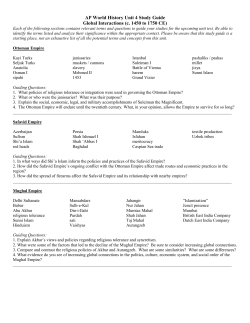
The English Renaissance 1485 - 1660
The English Renaissance 1485 - 1660 Names and Terms to Know A. • 1. Copernicus: Copernicus was a Polish astronomer who proposed that the earth moved around the sun. • 2. Henry VIII: Henry VIII was the second Tudor King of England. • 3. Armada: A fleet of ships, the Spanish Armada, tried to invade England, but failed. Names and Terms A cont. • 4. Elizabeth I: was the daughter of King Henry VIII and possibly England’s greatest monarch. • 5. James I: was the first Stuart King of England. He succeeded the childless Queen Elizabeth. • 6. Martin Luther: a German theologian, Luther taught that people needed a relationship with God, he began the Reformation Movement. Names and Terms B. • 1. Renaissance means rebirth. The Italian Renaissance was a rebirth of culture and renewed interest the classics. During the English Renaissance, England grew more powerful as a nation and absorbed and reworked new European ideas. Names and Terms B. cont. • 2. The Protestant Reformation created conflict in Europe and in English society. Protestants and Catholics fought each other and various monarchs represented either side. England first became Protestant under Edward VI (1547-1553), a brief Catholic restoration between 1553 and 1558 under Queen Mary, and return to Protestantism by Elizabeth (1558-1603), Names and Terms B. cont. • 3. During Elizabeth’s reign, England asserted itself as a military power against Spain. The nation prospered and was culturally enriched by the influence of the European Renaissance. England's literature blossomed as well as poetry and drama . Essential Question 1 A 1. A real place as a Launching Pad for the Imagination a. Elizabethans came to the theater to be amused, uplifted, and instructed. b. William Shakespeare wrote his play Macbeth in order to gain favor with James I who was Scottish and fascinate with witchcraft. Essential Question 1 A cont. 2. Drama and the Expansion of London a. Why were plays staged outside of London’s city limits? Actors and plays were officially regarded as disreputable. b. Why did writers come to London? To enjoy the stimulating life of a bubbling, artistic community. Essential Question 1 A cont. • 3. Pastoral Dreams • a. What did Greek and Roman pastoral poems do? They celebrated the beauties of a simple or natural life. • b. English poets wrote pastorals in order to: escape from the stresses of a city life. • c. Give an example of one English pastoral and its author: Christopher Marlowe’s, “The Passionate Shepherd to his Love.” Essential Question 1 A cont. • 4. Change in the Meaning of “England” • a. What two events launched England in the world stage? The defeat of the Spanish Armada and colonization of the New World. • b. By the early 1600’s, English writing was being read by people all over the known world. Essential Question 1 B • B. Follow the directions and complete 1,2,and 3 on your own. Essential Question 2 • 1. Belief as an Issue • a. During this time the religious affiliation of England changed four times. • b. How were religious and political loyalties tied together during the time of the Tudors? Catholic and Protestant rulers determined the current national religion, and those who supported the monarch were those who practiced his or her religion. Essential Question 2 A cont. • 1. cont. • c. Why was Sir Thomas More executed? He opposed King Henry VIII’s divorce and his Church of England. (He remained loyal to the Pope.) • d. What was Mary Tudor's policy regarding religion? She restored Catholicism and persecuted Protestants. Essential Question 2 A cont. • 2. Writer’s Response to Problems of Belief. • a. What was the “King James Bible” intended to accomplish? To provide a single scripture for the Church of England. • b. What scientific issues were also in dispute at this time? The shape of the earth and earth’s relationship to the sun. Essential Question 2 A cont. • 2. cont. • c. What s a major theme in Shakespeare’s play Macbeth? How to separate illusion from reality. • d. How did Columbus, Luther, Galileo, and Copernicus affect people’s beliefs? Columbus brought Europe to the New World, Luther enabled people to find an alternative to Catholicism, Galileo and Copernicus showed that people’s beliefs about the universe were wrong. Essential Question 2 B. • B. Follow the directions and complete 1,2,and 3 on your own. Essential Question 3 • 1. Rediscovering the Classics • a. Both the Renaissance and the Reformation involved going back to earlier writings and translating them for new ones. • b. How did the views of the ancient Greek and Roman classic writers differ from the views of traditional Christians? The Greeks and Romans were pagans. Essential Question 3 cont. • 1. cont. • c. What is Humanism? Humanism is based on the values of classical writers, and presents a human-centered view of life. • d. Give three examples of classic works that were translated into English during the Renaissance. Homer’s Iliad, Plutarch’s Lives, ad Virgil's Aeneid. Essential Question 3 cont. • 3. Religion and Literary Tradition • a. In what country did the sonnet for originate? Italy • b. Describe how the “King James Bible” came into being. King James wanted a standardized bible for the churches to use. The scholars he appointed used Latin, Greek, and Hebrew texts. The King James bible is still in use today. Essential Question 3 • B. Follow the directions and complete 1,2,and 3 on your own.
© Copyright 2025





















